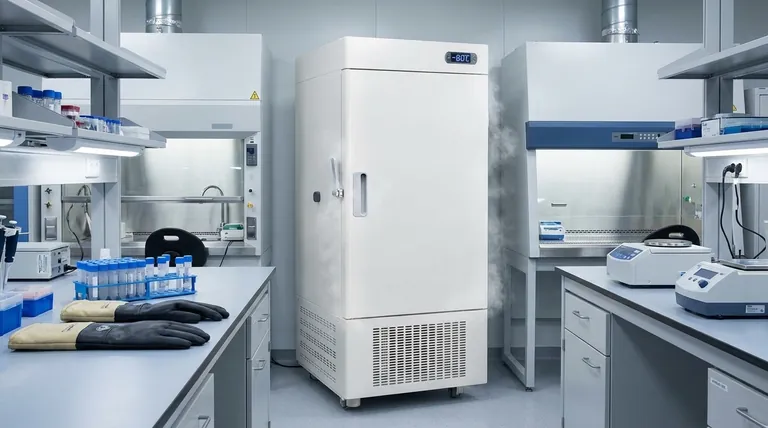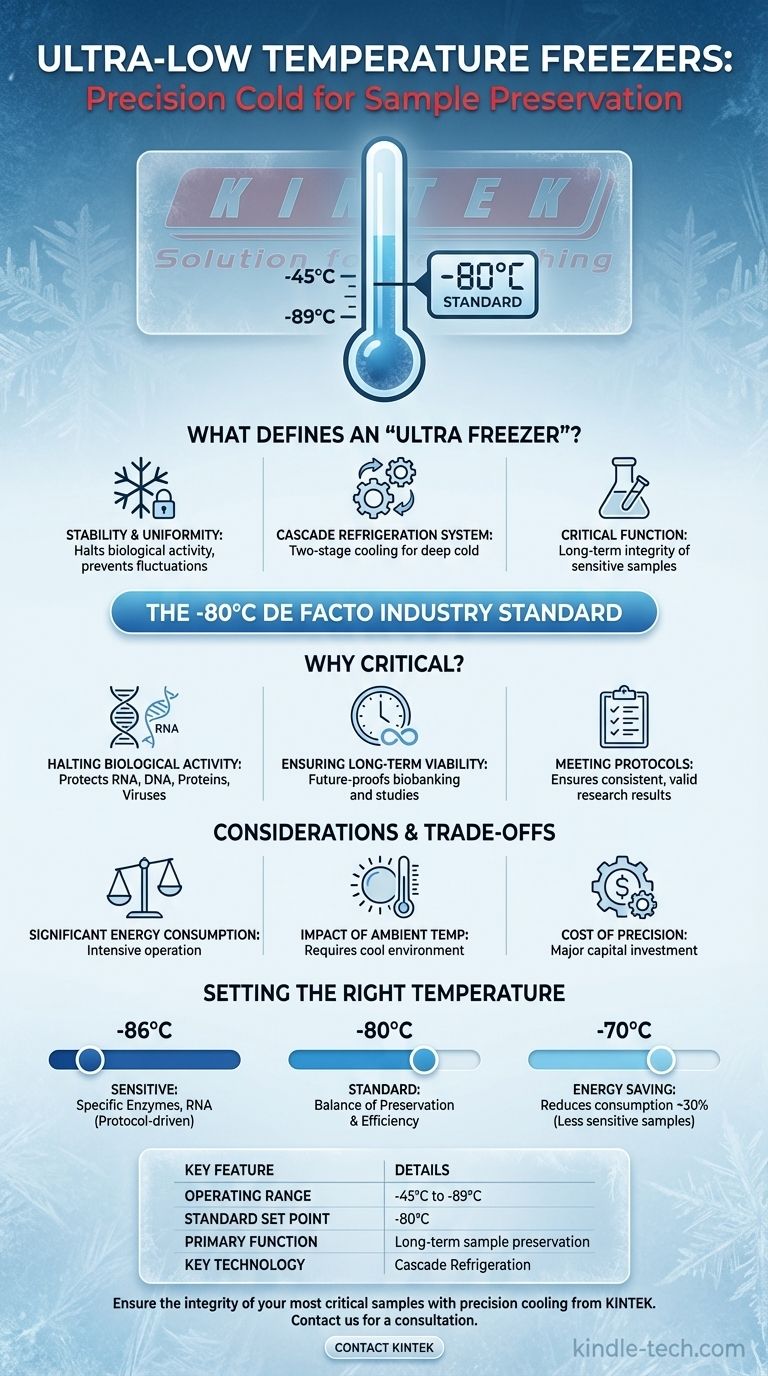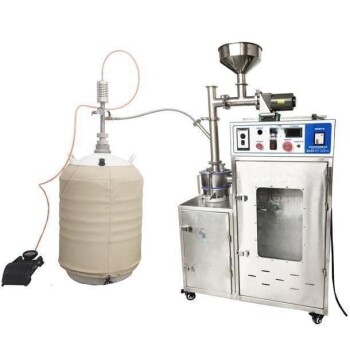In short, an Ultra Freezer, often referred to as an Ultra-Low Temperature (ULT) freezer, is designed to operate within a precise and exceptionally cold range. The standard operational temperature for these units typically falls between -45°C and -89°C.
The critical function of an Ultra Freezer is not just reaching extreme cold, but maintaining a highly stable and uniform environment. This precision is essential for halting biological activity and preserving the long-term integrity of sensitive scientific samples.

What Defines an "Ultra Freezer"?
Understanding the operational temperature is the first step. The next is understanding what makes this specific capability so vital in scientific and medical settings.
Beyond Simple Cold
Unlike a standard freezer, a ULT freezer's value lies in its stability and uniformity. It is engineered to minimize temperature fluctuations, which can damage or destroy invaluable biological materials over time.
The Technology Behind the Temperature
To achieve and maintain these cryogenic temperatures, ULT freezers use a specialized cascade refrigeration system. This involves two separate refrigeration circuits that work in stages to efficiently remove heat, a process far more complex and powerful than the single system found in a household unit.
The -80°C Standard
While the operational range is broad, the vast majority of laboratories and research facilities set their ULT freezers to -80°C. This specific temperature has become the de facto industry standard for the long-term storage of most biological samples.
Why This Temperature Range is Critical
Operating at temperatures below -45°C is non-negotiable for many applications, as it directly impacts the viability of the materials being stored.
Halting Biological Activity
At -80°C, virtually all metabolic and biological processes cease. This state of suspended animation prevents the degradation of sensitive molecules like RNA, DNA, proteins, and viruses, which would otherwise break down at warmer temperatures.
Ensuring Long-Term Viability
For long-term biobanking and longitudinal studies, sample integrity is paramount. The consistent, ultra-low environment of a ULT freezer ensures that samples collected today will be viable for analysis years or even decades in the future.
Meeting Research and Clinical Protocols
Strict protocols govern scientific research and clinical trials. Many of these procedures explicitly mandate storage at or below -80°C to ensure that results are consistent, repeatable, and valid.
Understanding the Trade-offs and Considerations
While essential, operating a ULT freezer involves significant practical considerations that must be managed.
Significant Energy Consumption
ULT freezers are among the most energy-intensive pieces of equipment in a laboratory. Maintaining such a large temperature differential between the inside and the outside requires constant work from the compressor system.
The Impact of Ambient Temperature
The freezer's performance is directly affected by the temperature of the room it's in. A warmer room forces the freezer to work harder, increasing energy use and strain on its components. Proper ventilation is crucial.
The Cost of Precision
The specialized technology required for cascade refrigeration systems means that ULT freezers are expensive to purchase, maintain, and repair. They are a major capital investment for any institution.
Setting the Right Temperature for Your Needs
Choosing a set point within the freezer's range is a balance between ensuring sample integrity and managing operational costs.
- If your primary focus is general long-term sample preservation: A set point of -80°C is the industry standard that offers a proven balance of preservation and energy efficiency.
- If your primary focus is storing highly sensitive materials like specific enzymes or RNA: You may need to use the lower end of the range, closer to -86°C, as dictated by your specific protocol.
- If your primary focus is minimizing energy costs for less sensitive samples: Operating at -70°C instead of -80°C can reduce energy consumption by up to 30% without compromising many common sample types.
Ultimately, selecting the correct temperature within your Ultra Freezer's range is a critical decision that balances preservation requirements against operational efficiency.
Summary Table:
| Key Feature | Details |
|---|---|
| Standard Operating Range | -45°C to -89°C |
| Industry Standard Set Point | -80°C |
| Primary Function | Long-term preservation of biological samples |
| Key Technology | Cascade Refrigeration System |
Ensure the integrity of your most critical samples with precision cooling from KINTEK.
Choosing the right Ultra-Low Temperature (ULT) freezer is vital for the long-term viability of your biological materials, including DNA, RNA, proteins, and vaccines. KINTEK specializes in providing reliable lab equipment and consumables tailored to the exacting needs of modern laboratories.
Our ULT freezers are engineered for exceptional temperature stability and uniformity, helping you meet strict research and clinical protocols while managing operational costs. Let our experts help you select the ideal equipment to protect your invaluable work.
Contact KINTEK today for a consultation and discover how our solutions can enhance your lab's capabilities.
Visual Guide

Related Products
- 308L Precision Ultra Low Temperature Freezer for Laboratory Applications
- 158L Precision Vertical Ultra Low Freezer for Laboratory Applications
- 28L Compact Upright Ultra Low Temperature Freezer for Laboratory
- 508L Advanced Vertical Ultra Low Temperature Freezer for Critical Laboratory Storage
- 108L Vertical Ultra Low Temperature ULT Freezer
People Also Ask
- Why are ultra-low temperature freezers important in scientific research? Ensure Sample Integrity and Reproducibility
- What advantages do ultra-low temperature freezers offer? Ensure Long-Term Sample Integrity and Reliability
- What are the common applications of ultra-low temperature freezers? Preserve Your Most Valuable Samples
- What temperature range do Ultra-Low Temperature freezers maintain? The -80°C Standard for Sample Integrity
- How do ultra-low temperature freezers work? Unlocking the Secrets of -86°C Sample Preservation



















